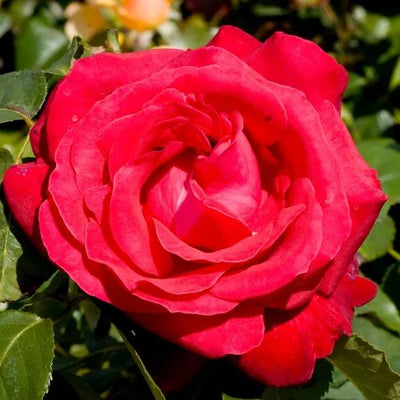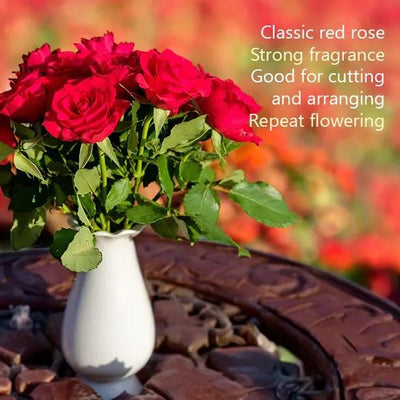Order Potted Hybrid Tea Rose Bushes Now For October Delivery
Pre-Order Bareroot Hybrid Tea Roses For 2025/26 Winter Planting Season
When you imagine perfectly formed, scrolled flowers, one bloom per long, straight stem, you have a hybrid tea in mind.
They have more fragrance than floribunda roses, and their flowers are larger and more complex, perfect for cutting.Shrub roses, which include all the old varieties, tend to be bigger, thornier, and have a wide range of flower shapes.
The "unofficially official" birthdate of modern rose bushes is that of the first hybrid tea's: 1867, when 'La France' was named by Jean-Baptiste André Guillot (1827-1893).
The parent groups of old roses are Hybrid Perpetuals, which are profuse and repeat flowering, and Tea Roses, which mainly provide height and influence the flower shape.
Browse our other types of rose.
Pot grown stock uses peat free compost wherever possible.
Bareroot roses are grown on heavy clay in a well drained site (heaven for rose roots) and lifted to order.
- When your order is ready: your mail order rose bushes are delivered by next working day courier (not the next working day after ordering!)
- Friendly support: if there is anything wrong with your plants when you inspect them, Contact Us within 5 working days
All bareroot plants are covered by our Refund Guarantee, so you can give them a whirl with complete confidence.
Which Hybrid Tea Rose Varieties Should I Choose?
Some of the best shorter Hybrid Tea Rose varieties to under 80cm, well suited to growing near the front of the border, are:
Some of the best taller Hybrid Tea Rose to over 1 metre, well suited to growing near the back of the border, are:
Hybrid Tea roses in general are not shade-tolerant, but these two are the least worst for shady gardens:
Where can I grow Hybrid Tea Roses?
You can grow hybrid tea roses anywhere in the UK where there is a good amount of sunlight, drainage, and shelter from strong winds.
The ideal growing conditions are in full sun, but most varieties will tolerate a little shade as long as they are not crowded by neighbouring shrubs.
Still, you will get the best flower displays in a sunny, sheltered location.
Roses love heavy clay soil as it does not waterlog in winter, but any soil with good drainage can be improved by digging in well-rotted organic matter, and then yearly mulching.
Rose Replant Disease
Replant disease affects several plants, especially roses and other plants in the Rosacea family.
It occurs when you remove an old rose, and plant a new rose straight away in the same soil.
There are three main ways to avoid rose replant disease:
- The easiest way: plant a different shrub!
- The easy way: wait at least a full 12 months before planting a new rose in the site of an old one. Grow some annual bedding plants there instead for the interim - annual Sweet Peas are great because their roots fix nitrogen, but any mix of wild flowers is good.
- The hard way: dig out a block of soil at least 1 metre square on the surface and 40-50cm deep, and replace the soil with fresh stuff. Lining the sides of the hole with thick, plain (not glossy) cardboard may help.
Whichever method you choose, apply Rootgrow fungi when you replant the new rose, and feed it with rose food during the growing season.
When and How Do I Plant Hybrid Tea Roses?
What is the best time to plant Hybrid Tea roses?
Bareroot roses are by far the best value, the easiest to handle & plant because they weigh so little, and offer the most selection.
- Bareroot roses are only planted from about November to the end of March, weather depending. The perfect months are November and March, but anytime in winter is fine.
- Plant potted roses at any time, as long as you can water them during dry summer weather. In the hottest part of mid-summer, it is preferable to delay planting until the weather cools a bit to reduce stress on the plants.
How to Plant Hybrid Tea Roses
Watch our short video on planting a hybrid Tea Rose, which is the same as planting any bush rose.
Soil preparation is an important investment: a rose bush should live for at least 30-40 years.
Dig a square planting hole that is comfortably wide enough to spread the roots out, so they do not touch the sides, but not so deep that the graft union is buried*.
Improve the soil that you removed by adding about 25% well-rotted compost/manure before returning it to the hole.
Wet the roots, and then sprinkle them with Rootgrow.
Don't plant your roses too deep.
Water well immediately, and all through their first spring and summer.
*How Deep Should I Plant My Hybrid Tea Rose?
The short answer is that it really doesn't make a huge difference in most cases: you can plant so that the graft union is above soil level, at soil level, or a couple of inches below soil level.
The advantage of burying the graft union is that the rose will be very stable in the ground and won't suffer from "wind rock", which tends to affect taller shrub roses.
The advantage of keeping the graft union above ground is that it will always be completely clear which shoot are root suckers that need to be removed.
Even with a deep planted rose, it should still be obvious which is which: a sucker will have bright green bark and leaves, unlike most garden roses which are tinged with at least a little red.
If a sucker gets old enough to flower, they will be in small clusters, with a single row of white petals and yellow anthers.
When and How do I Prune Hybrid Tea Roses?
Pruning:
The best time to cut back your hybrid tea rose is in winter, when the leaves have fallen.
First, as with pruning any shrub, remove the DDD wood: Dead, Diseased, or Damaged (which includes crossing stems that are rubbing against each other).
If the plant is congested, cut out some of the oldest stems from the centre.
Then, cut every stem down to about 6 inches, 15cm, from its base.
Next, use secateurs to shorten the weakest, spindliest shoots down to about 3 inches, 5-10cm, or remove them entirely if they look really bad.
When your hybrid tea has been established for a couple of years, remove at least half of the oldest stems (i.e. at least three years old) each year, as the best flowering is from shoots on one and two-year-old wood.
Deadheading:
Hybrid tea roses bloom in waves (typically three), and you should deadhead the spent flowers as soon as they begin to fade by cutting back the stem back to the first set of five leaves below the flower (ideally to an outward facing bud) to encourage the best re-flowering.








 Secure, One-Tap Checkout
Secure, One-Tap Checkout
 Hand Picked, Delivered to Your Door!
Hand Picked, Delivered to Your Door! 1 Year Bareroot Guarantee
1 Year Bareroot Guarantee




































